
Key Takeaways
- Dandelions are nutrient powerhouses containing more beta-carotene than carrots, more iron than spinach, and are rich in vitamins A, C, and K.
- Every part of the dandelion is edible and medicinal—flowers, leaves, roots, and even seeds can be transformed into delicious and healing recipes.
- Dandelion root tea and tinctures can support liver health, reduce water retention, and potentially help regulate blood sugar levels.
- The bitter compounds in dandelion greens stimulate digestion and can be prepared in various ways to reduce their natural bitterness.
- Fresh Bites Daily offers expert guidance on harvesting and preparing dandelions for maximum nutritional benefit and medicinal potency.
Updated on November 1, 2025, with new details on dandelion’s benefits, flavour, and practical applications.
Dandelions: Nature’s Free Superfood Right in Your Yard
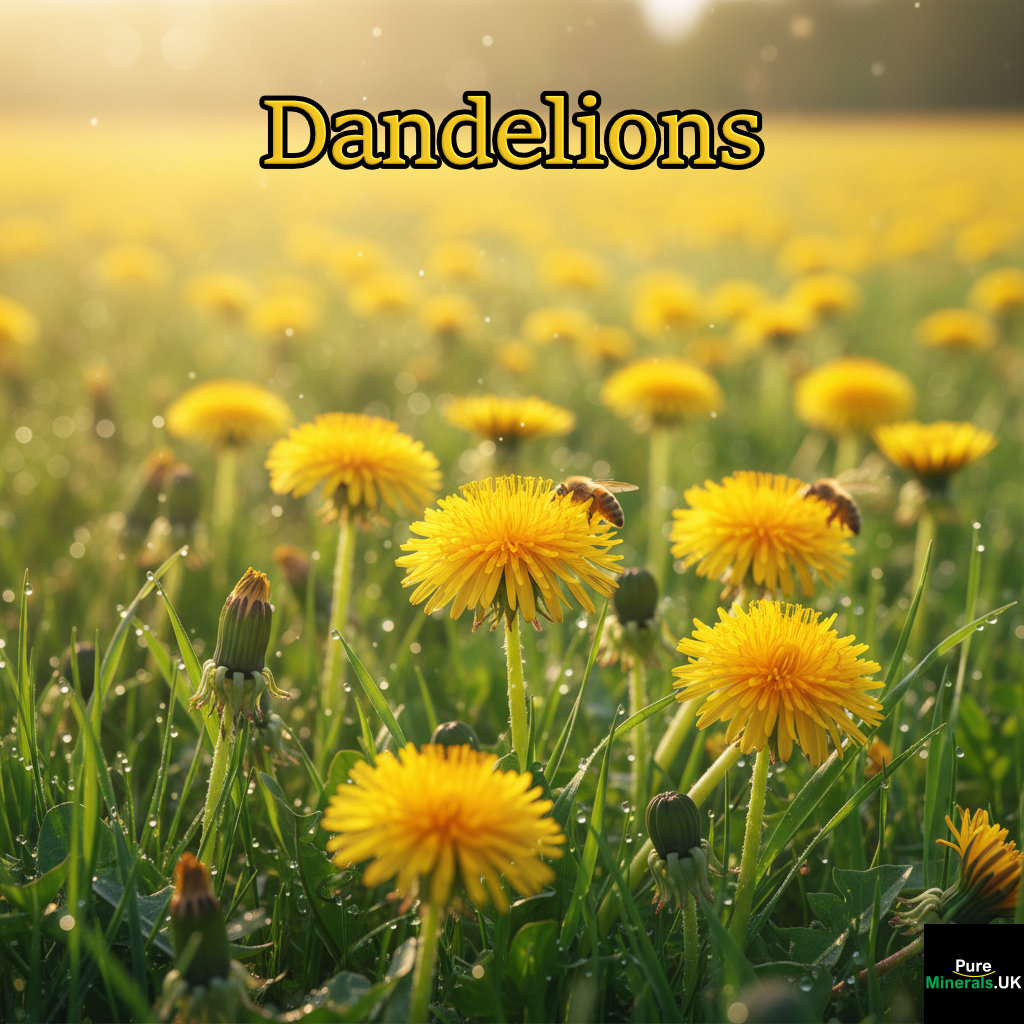
That yellow “weed” dotting your lawn isn’t just a nuisance—it’s a nutritional goldmine waiting to be harvested. Dandelions have been used for thousands of years in traditional medicine systems worldwide, from China to Native American cultures. Their impressive health benefits range from supporting digestion to improving liver function and reducing inflammation. What most people don’t realize is that these resilient plants offer free nutrition right outside your door, with every part being both edible and medicinal.
The humble dandelion (Taraxacum officinale) transforms from pesky lawn invader to valued health ally when you understand its potential. Rich in vitamins, minerals, and unique plant compounds, dandelions provide an accessible way to boost nutrition while connecting with natural food sources. Fresh Bites Daily has been championing these golden blossoms as culinary treasures that deserve a place in your kitchen rather than being doused with weed killer.
Before dismissing dandelions as mere lawn nuisances, consider that they’ve been purposefully cultivated in gardens throughout history specifically for their culinary and medicinal uses. The roots, leaves, flowers, and even the fluffy seed heads can be transformed into teas, tinctures, wines, and delicious food. As you’ll discover, incorporating these versatile plants into your wellness routine might be one of the simplest and most rewarding steps toward better health.
Nutritional Powerhouses: What Makes Dandelions So Healthy

Dandelions pack a nutritional punch that rivals many store-bought vegetables. These sunshine-yellow flowers and their accompanying greens contain more beta-carotene than carrots, more iron than spinach, and more calcium than most greens. They’re also loaded with vitamins A, C, and K, plus minerals including potassium, magnesium, and zinc—making them true nutritional all-stars.
Essential Vitamins and Minerals in Dandelions
The vitamin content in dandelions is particularly impressive, with just a cup of raw dandelion greens providing 112% of your daily vitamin A requirements and 32% of vitamin C. These vitamins support immune function, vision health, and skin regeneration. The mineral profile is equally remarkable, with dandelions offering substantial amounts of calcium, iron, and potassium that support bone health, oxygen transport, and proper muscle function. What sets dandelions apart from many commercial vegetables is their bioavailable nutrition—meaning these nutrients are readily absorbed by your body rather than passing through undigested.
Powerful Antioxidants and Their Benefits
Beyond vitamins and minerals, dandelions contain powerful antioxidants including beta-carotene, lutein, and zeaxanthin. These compounds help neutralize harmful free radicals in the body that can damage cells and contribute to aging and disease. The bitter compounds that give dandelion greens their distinctive flavor—primarily taraxacin and taraxasterol—aren’t just there for taste; they stimulate digestive function and support the body’s detoxification pathways. Research suggests these antioxidants may help reduce inflammation and oxidative stress, potentially lowering risk factors for chronic diseases.
Natural Detoxification Properties
Dandelions have earned their reputation as natural detoxifiers thanks to their diuretic and liver-supporting properties. The roots especially contain compounds that stimulate bile production, helping your liver filter toxins more efficiently. This natural detoxification support has earned dandelion the folk name “liver tonic” in many traditional healing systems. Unlike pharmaceutical diuretics, dandelion’s natural water-removing properties don’t deplete the body of potassium—in fact, they provide it abundantly, making them a balanced way to reduce water retention and support kidney function.
Harvesting Dandelions Safely
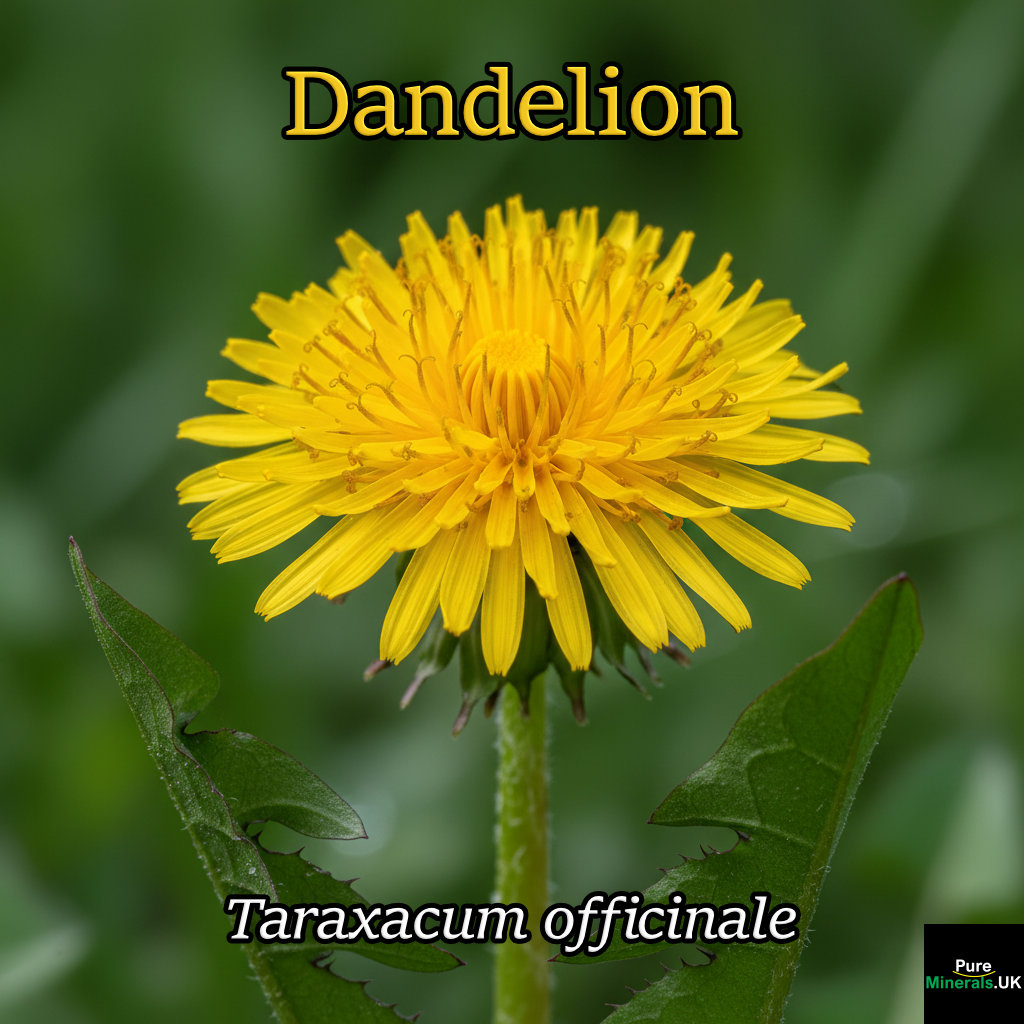
Before rushing outside to gather dandelions, understanding proper harvesting techniques ensures you’ll collect the most nutritious plants while avoiding potential contamination. The good news is that dandelions are easy to identify with their distinctive toothed leaves (the name “dandelion” comes from the French “dent de lion” meaning “lion’s tooth”), bright yellow flowers, and hollow stems that exude a milky sap when broken. Proper identification matters, though dandelions are rarely confused with harmful look-alikes.
When harvesting, bring a basket or paper bag, a knife or garden scissors, and gloves if you prefer to keep your hands clean from the milky latex in the stems. Choose areas far from roadways, industrial sites, and lawns treated with chemicals. Parks, meadows, and your own untreated yard offer the safest harvesting grounds. Remember that taking just what you need ensures dandelion populations will continue to thrive—these plants are important early food sources for pollinators.
When to Pick for Maximum Nutrition
Timing matters when harvesting dandelions for maximum nutritional benefit. Young leaves harvested in early spring before flowering offer the mildest flavor and highest vitamin content. Flowers should be gathered when fully open on sunny mornings after the dew has dried but before the heat of the day. Roots are best harvested in fall or early spring when the plant has concentrated its energy in the root system, making them richer in medicinal compounds and inulin—a prebiotic fiber that supports gut health.
Quick Field Guide for Identifying the True Dandelion (Taraxacum officinale) from Common Rosette Look‑alikes
Core ID for true dandelion (Taraxacum)
Leaves: All in a basal rosette; deeply lobed with sharp, backward‑pointing lobes; mostly smooth (often nearly hairless); exude milky latex when cut.
Stalks (scapes): Leafless, unbranched, hollow; one flower head per stalk; many stalks can arise from one crown.
Flower head: All yellow “ray” florets (no central disc florets). Two rows of bracts; the outer row typically bends backward (reflexes) after opening.
Seed head: Spherical “clock”; each seed (achene) has a long, slender beak with a silky pappus.
Fast decision steps…
One head per leafless stalk that’s hollow? → Likely Taraxacum.
Is it stalk-branched, or has leaves/bracts along it? → Not Taraxacum.
Leaves are very hairy with rounded lobes → Often Catsear/Hawkbit, not Taraxacum.
Tall plant with obvious stem leaves? → Sowthistles, Hawksbeards, Prickly lettuce, not Taraxacum.
Identifying Common Dandelion Look‑alikes
Catsear / Flatweed (Hypochaeris radicata)

Stems: Solid (not hollow), wiry, usually branched; several heads per stem; may have small bracts below heads.
Leaves: Hairy, lobes blunt/rounded; rosette only.
Key split: Solid, branched stems vs dandelion’s hollow, unbranched scapes.
Rough hawkbit (Scorzoneroides autumnalis; formerly Leontodon)

Stems: Usually branched (often from a single scape) with multiple heads.
Leaves: Hairy, less sharply lobed than dandelion.
Key split: Branched scapes; overall “tuft of small heads” look.
Hawksbeard (Crepis spp.)

Stems: Branched, with small, clasping leaves up the stem.
Heads: Many smaller yellow heads in open clusters.
Key split: True aerial stems with leaves (not just basal rosette).
Sowthistles (Sonchus oleraceus, S. asper)
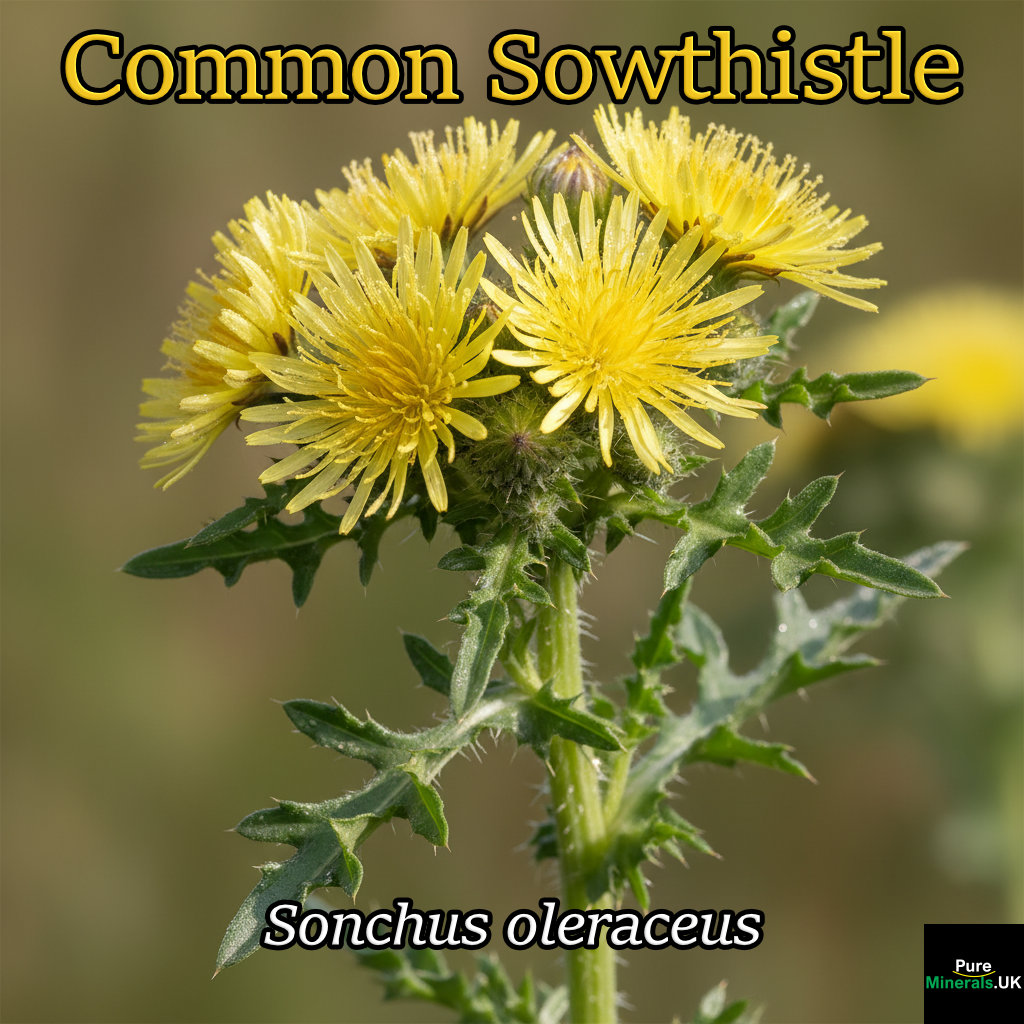
Stems: Hollow, branched, with large clasping “auricled” stem leaves; milky latex.
Leaves: Often prickly (especially S. asper).
Key split: Big stem leaves; much taller than dandelion.
Prickly lettuce (Lactuca serriola)
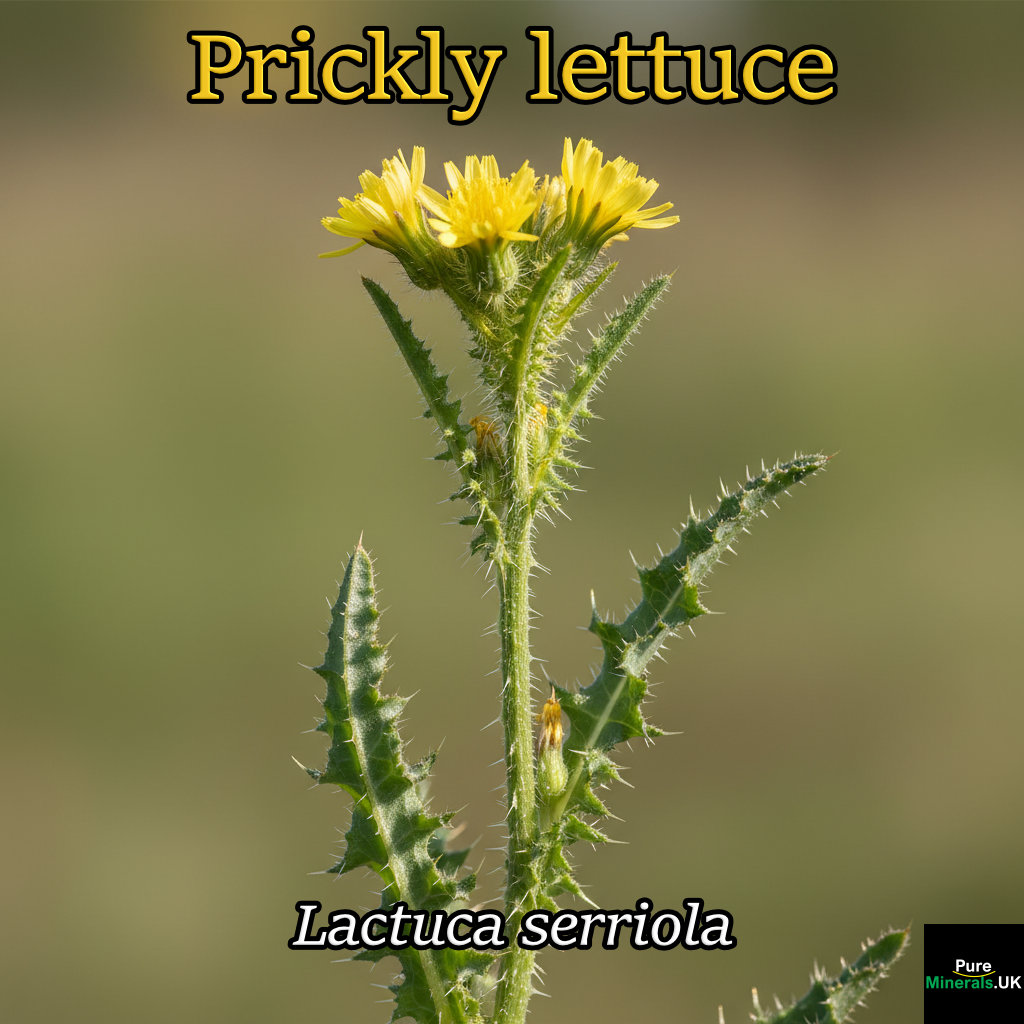
Stems: Tall, with spines on the underside of leaf midrib; leaves align vertically (compass-like).
Heads: Small, many; yellow.
Key split: Spiny midrib and tall, leafy stems.
Coltsfoot (Tussilago farfara)
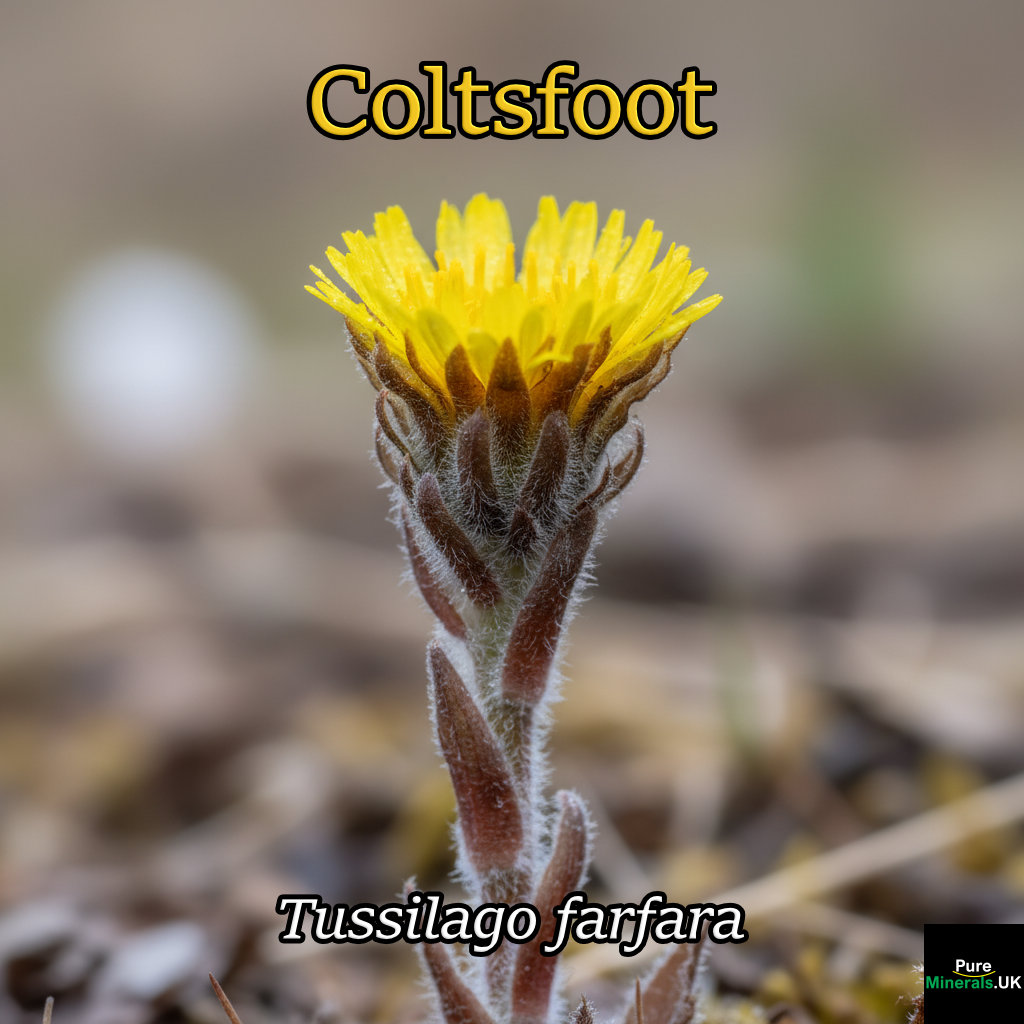
Phenology: Flowers appear before leaves; scaly flower stems.
Leaves: Heart-shaped, felted beneath, appear after flowering.
Key split: Flowering with no basal leaves present.
Capeweed (Arctotheca calendula)
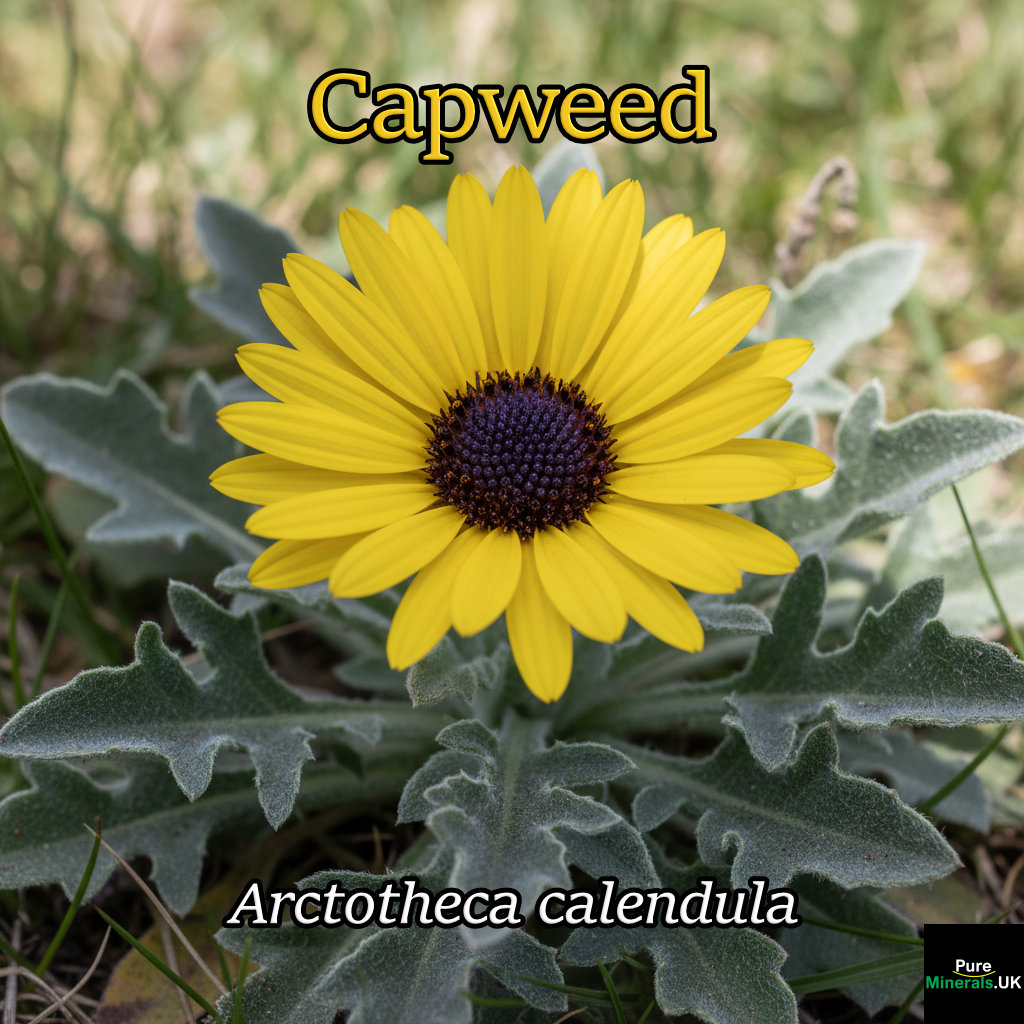
Habit: Mat-forming; leaves white‑woolly beneath.
Heads: Often with a dark “eye” in the center.
Key split: Woolly leaf undersides and dark-centered heads.
Dandelion Testing Field Tips
Snap test: Dandelion scapes are hollow and exude milky latex; Catsear’s are solid. Note: many relatives also have latex, so use this with the other traits.
Bract check: Dandelion’s outer head bracts reflex strongly downward after opening—good confirmation.
Leaf texture: Smooth, sharply toothed = Dandelion; conspicuously hairy with rounded lobes = Catsear/Hawkbit.
Architecture: A true dandelion never has leafy, branching stems; each stalk carries just one head from the rosette.
Which Parts of the Dandelion to Use for Different Recipes
Each part of the dandelion serves different culinary and medicinal purposes. The sunny yellow flowers lend themselves beautifully to sweet preparations like jellies, wines, and fritters, offering a mildly sweet honey-like flavor. Young leaves work wonderfully in salads, pestos, and sautés, providing a nutritious bitter green comparable to arugula. The roots, when cleaned, dried, and roasted, make an excellent coffee substitute while also lending themselves to medicinal tinctures and decoctions for liver support. Even the unopened flower buds can be pickled as “dandelion capers” for a nutritious condiment.
Avoiding Dandelions in Chemically-Treated Areas
Safety is paramount when foraging dandelions. Never harvest from areas that may have been sprayed with pesticides, herbicides, or chemical fertilizers. Stay at least 50 feet from busy roadways where lead and other pollutants might contaminate plants. Avoid areas where dogs frequently visit, and when harvesting from public spaces, always check local regulations about foraging. If you’re unsure about an area’s chemical history, it’s best to err on the side of caution—dandelions are abundant enough that you can afford to be selective about your harvesting spots.
Washing Dandelions
Thorough cleaning is essential for wild-harvested dandelions. For greens and flowers, soak them in cool water with a splash of vinegar for 5-10 minutes to remove any insects or debris, then rinse thoroughly under running water. Repeat this process at least once more, checking carefully for any remaining dirt or tiny insects. Roots require more intensive cleaning—scrub them with a vegetable brush under running water, then slice and check for any remaining soil in the crevices. For medicinal preparations, peeling the roots may be necessary to ensure complete cleanliness. If you’re interested in learning about other herbs, explore the benefits of chervil as well.
Delicious Dandelion Flower Recipes
Dandelion flowers add a splash of sunshine to your plate with their mild, slightly sweet flavor reminiscent of honey. These golden blossoms aren’t just pretty—they contain antioxidants, especially lutein, which supports eye health. When cooking with the flowers, remove the green sepals at the base (which can add bitterness) and use just the yellow petals for the mildest flavor. Fresh flowers should be used quickly after harvesting, ideally the same day, as they tend to close up and lose their vibrant appearance. For a unique twist, try adding cinnamon to your dandelion recipes to enhance their natural sweetness.
Dandelion Wine: A Spring Tradition

Dandelion wine is perhaps the most celebrated use of these flowers, with recipes passed down through generations. This homemade elixir transforms simple blossoms into a delicate, slightly floral white wine that tastes nothing like the bitter greens. The traditional process involves steeping dandelion petals with citrus, sugar, and wine yeast, then fermenting for several months to develop a complex, honey-like flavor profile. The result is a golden-hued wine that captures spring sunshine in a bottle, perfect for celebrating the season of renewal.
Sweet Dandelion Honey and Syrup
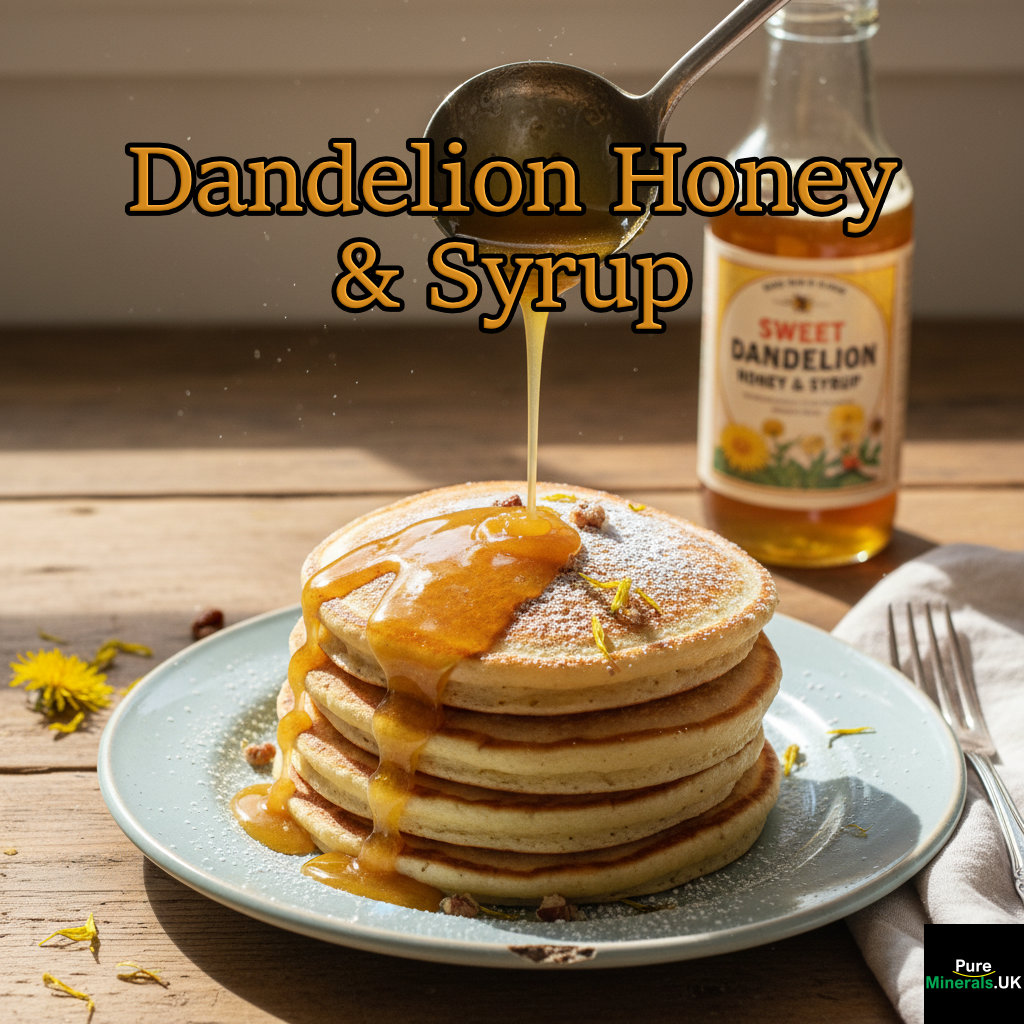
For those seeking a quicker reward from their dandelion harvest, homemade dandelion “honey” delivers sweet satisfaction without requiring fermentation. This vegan honey alternative is made by simmering dandelion petals with water, sugar, and lemon, resulting in a golden syrup with subtle floral notes. The natural pectin in the flowers helps achieve the perfect consistency, while the gentle heat extracts the flowers’ essence. This sweet treat can be drizzled over pancakes, stirred into tea, or used in any recipe calling for honey, providing a taste of spring year-round.
Crispy Dandelion Fritters

Transform whole dandelion flower heads into delectable treats by dipping them in a light batter and flash-frying until golden and crisp. These fritters make a surprisingly elegant appetizer or snack, with the flowers opening up like little stars within their crispy coating. The natural sweetness of the petals balances beautifully against the savory batter, especially when seasoned with a pinch of salt and herbs like chives. For a sweet variation, dust the finished fritters with cinnamon sugar and serve with a dollop of honey for dipping—a delightful way to appreciate these abundant blossoms.
Flower-Infused Desserts and Treats
Dandelion flowers can elevate everyday treats with their subtle honey-like essence and vibrant color. Infuse the petals into cream for uniquely flavored ice creams, custards, and panna cottas that carry the essence of spring meadows. For a simple yet impressive dessert, fold dandelion petals into cookie dough or cake batter—they add eye-catching flecks of yellow and a mild sweetness. Dandelion-infused butter makes a delightful spread for morning toast, while dandelion flower jelly captures the essence of spring in a jar to be enjoyed year-round.
The versatility of dandelion flowers in sweet preparations stems from their surprisingly delicate flavor, which adds a subtle complexity without overwhelming. Combining these flowers with citrus or honey enhances their natural sweetness while balancing any trace of bitterness from the green parts. Using these blossoms in your kitchen not only adds unique flavor but also provides antioxidants and a connection to traditional foodways that modern diets often miss.
Healing Dandelion Root Remedies
The humble dandelion root contains potent medicinal properties that have been valued in traditional healing systems for centuries. Beneath the soil, these roots store compounds that support liver function, aid digestion, and help the body eliminate excess water. Fall-harvested roots contain the highest levels of inulin, a prebiotic fiber that feeds beneficial gut bacteria. The bitter compounds in dandelion roots stimulate digestive secretions, potentially improving nutrient absorption and preventing digestive discomfort. For more information on similar roots, you can explore chicory, which also contains inulin.
Dandelion Root Coffee Substitute
For those looking to reduce caffeine while still enjoying a rich, roasted morning beverage, dandelion root coffee provides a satisfying alternative. After thorough cleaning, the roots are chopped, dried, and roasted until they turn a deep brown color and develop a rich aroma reminiscent of coffee. When ground and brewed, this caffeine-free alternative offers earthy, nutty flavors with subtle bitter notes that mimic coffee’s complexity. Beyond its pleasing taste, this beverage supports liver function while providing the ritual of a warm morning cup without caffeine’s potential side effects.
The process of creating dandelion root coffee connects us to traditional food preparation methods that maximize both flavor and medicinal benefits. The roasting process not only develops flavor but also makes the roots’ beneficial compounds more bioavailable. For those sensitive to acidic beverages, dandelion coffee offers a gentler alternative that won’t trigger reflux or stomach discomfort. Adding warming spices like cinnamon, cardamom, or vanilla can enhance the flavor profile while contributing additional health benefits.
Traditional Dandelion Root Coffee Recipe
Ingredients:
– 1 pound fresh dandelion roots, thoroughly cleaned
– Optional: 1 cinnamon stick, 2 cardamom pods, or 1 vanilla beanProcess:
1. Chop roots into small, even pieces
2. Dry in a dehydrator or oven at 200°F until completely dry
3. Roast at 350°F for 20 minutes, stirring occasionally until dark brown and fragrant
4. Grind and brew using 1 tablespoon per cup of water
5. Strain and enjoy with optional milk and sweetener
Many people who try dandelion root coffee are surprised by its rich flavor and satisfying mouthfeel. While it doesn’t contain caffeine, many report that it provides a gentle energy lift without the crash that can follow coffee consumption. This likely comes from improved liver function and blood sugar regulation rather than stimulant effects. As an added benefit, the inulin in dandelion roots supports healthy gut flora, potentially improving overall digestive health with regular consumption.
Digestive-Supporting Tinctures
Dandelion root tinctures offer concentrated medicinal benefits in an easily absorbable form. Creating a tincture involves soaking freshly harvested, chopped dandelion roots in high-proof alcohol (like vodka) for 4-6 weeks, allowing the alcohol to extract the root’s beneficial compounds. This method preserves the medicinal properties for up to five years while making them instantly available to the digestive system when consumed. A standard dose of 1/4 to 1/2 teaspoon before meals can stimulate digestive juices, potentially improving nutrient absorption and reducing symptoms of indigestion.
The bitter compounds in dandelion root tincture, primarily taraxacin and taraxasterol, trigger a cascade of digestive responses when they contact taste receptors. This “bitter reflex” increases saliva production, stimulates stomach acid secretion, and promotes bile release from the gallbladder—all crucial components of healthy digestion. For those with sluggish digestion, gas, bloating, or feelings of heaviness after meals, dandelion tincture offers a simple yet effective solution derived from traditional herbal wisdom.
Liver-Cleansing Root Tea
Dandelion root tea stands out as one of the most effective herbal supports for liver function and gentle detoxification. The roots contain compounds that increase bile production and flow, helping the liver process fats more efficiently while aiding in the removal of waste products. Making this medicinal tea involves simmering chopped, dried roots for 15-20 minutes to extract the beneficial compounds—a process called decoction. For enhanced liver support, many herbalists recommend combining dandelion root with complementary herbs like burdock root or yellow dock, creating a synergistic blend that addresses multiple aspects of detoxification.
Daily consumption of dandelion root tea can provide ongoing support for liver health, particularly beneficial in our modern world where environmental toxins are increasingly common. The tea’s slightly bitter, earthy flavor becomes more palatable over time as taste buds adjust, and many people find it quite enjoyable when enhanced with cinnamon, ginger, or a touch of honey. Beyond liver support, this humble tea may help improve skin conditions, reduce joint inflammation, and support healthy blood sugar levels—all benefits linked to improved liver function and reduced toxic burden.
Nutrient-Rich Dandelion Greens in the Kitchen
Dandelion greens deserve a place among prized culinary greens like arugula and radicchio, offering a similar bitter profile with superior nutritional benefits. These nutrient-dense leaves contain more protein, calcium, iron, and potassium than most grocery store greens while providing substantial amounts of vitamins A, C, and K. The key to enjoying dandelion greens lies in understanding how to balance their natural bitterness with complementary flavors and cooking techniques that transform them into delicious culinary creations. For those interested in exploring similar greens, chicory is another great option to consider.
Professional chefs have long appreciated dandelion greens for their complex flavor profile and ability to add dimension to dishes. In Mediterranean cuisine, dandelion greens frequently appear in soups, pasta dishes, and alongside hearty beans. The Italian tradition of “bitter greens” celebrates these flavors rather than trying to eliminate them, recognizing their role in stimulating digestion and cleansing the palate. By adopting these traditional approaches to bitter flavors, you can unlock both culinary delights and health benefits from this abundant wild green.
Bitter-Balancing Preparation Methods
Taming the bitter edge of dandelion greens makes them more approachable for everyday enjoyment. Blanching the leaves briefly in boiling salted water before using them in recipes can significantly reduce bitterness while preserving much of their nutritional value. Pairing dandelion greens with sweet ingredients like caramelized onions, roasted beets, or dried fruits creates a balanced flavor profile that highlights the greens without allowing bitterness to dominate. Fat also helps balance bitter flavors, making olive oil, bacon, or toasted nuts excellent companions for dandelion greens in various dishes.
Young, tender dandelion leaves harvested before the plant flowers offer a milder flavor profile ideal for salads and quick cooking methods. As the season progresses and the plants mature, the increased bitterness in older leaves makes them better suited for cooking methods that mellow their intensity, such as braising or sautéing. This seasonal progression allows you to enjoy different preparations throughout spring and early summer, adapting your cooking techniques to match the changing flavor profile of these nutritious greens.
Vibrant Dandelion Pesto

Transform nutritious dandelion greens into a vibrant, flavorful pesto that maintains their health benefits while creating a versatile condiment. Traditional pesto ingredients like garlic, nuts, oil, and cheese help balance dandelion’s bitterness while amplifying its nutritional profile. The result is a bright green sauce bursting with vitamins, minerals, and beneficial plant compounds that can elevate simple dishes from pasta to grilled vegetables or fish. Unlike basil pesto, dandelion pesto has a more robust flavor that stands up beautifully to hearty foods and stronger flavors.
For the best dandelion pesto, blanch the greens briefly to reduce bitterness before blending with toasted pine nuts or walnuts, high-quality olive oil, fresh garlic, and Parmesan or nutritional yeast for a dairy-free version. Adding a squeeze of lemon juice brightens the flavor while helping preserve the pesto’s vibrant green color. This nutrient-dense condiment keeps in the refrigerator for up to a week, allowing you to add a nutritional boost to multiple meals with minimal effort—a perfect way to incorporate wild foods into a busy modern lifestyle.
Green Smoothie Additions
Adding a small handful of young dandelion greens to morning smoothies offers a simple way to incorporate their nutritional benefits into your daily routine. Their bitter compounds stimulate digestion first thing in the morning, potentially improving nutrient absorption throughout the day. When balanced with sweeter ingredients like ripe bananas, berries, or mango, the bitterness becomes barely noticeable while the nutritional benefits remain intact. This approach is particularly effective for those new to dandelion’s flavor or for introducing these nutritious greens to children.
Sautéed Greens Side Dishes
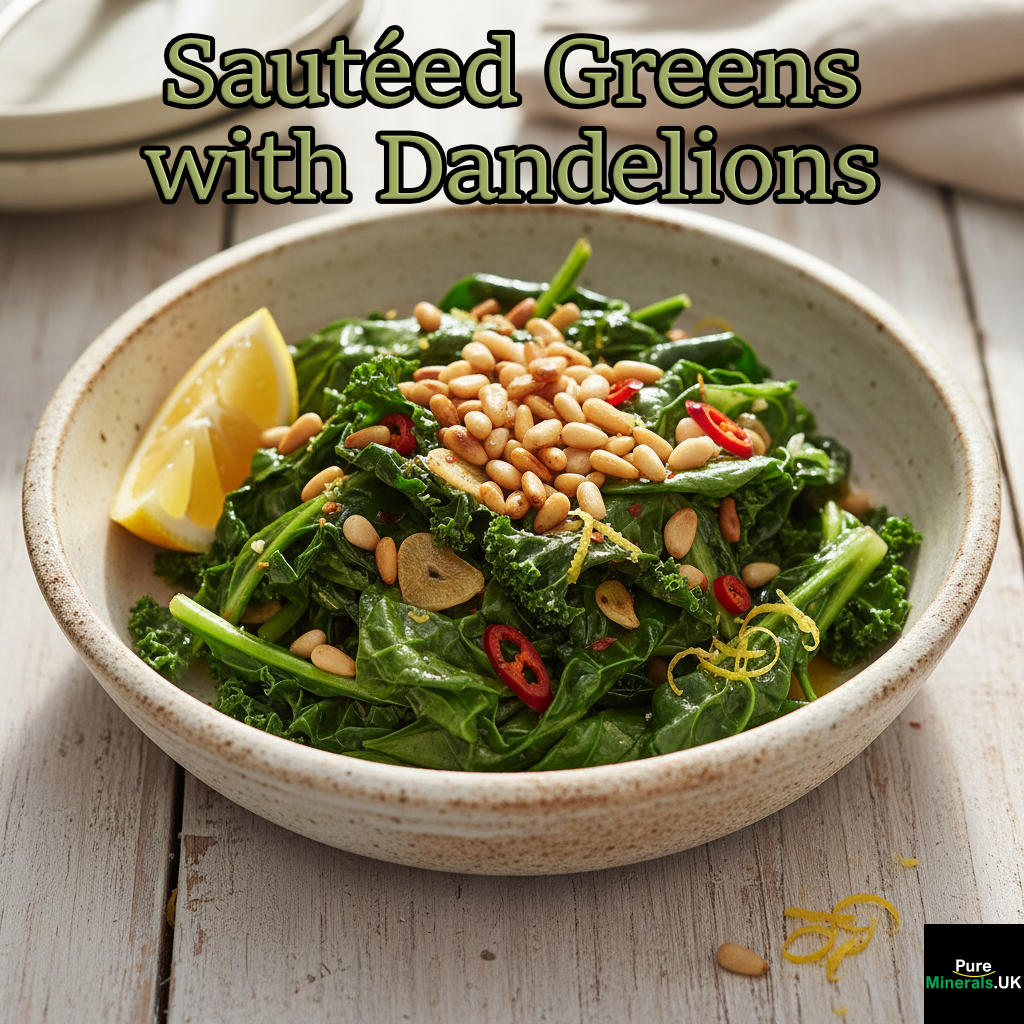
A classic preparation of dandelion greens involves sautéing them with complementary ingredients that balance their natural bitterness while creating a nutrient-dense side dish. Garlic, olive oil, and a splash of acid from lemon juice or vinegar create a Mediterranean-inspired dish that pairs beautifully with grilled proteins or hearty beans. Adding a pinch of red pepper flakes introduces a pleasant heat that further distracts from any residual bitterness, while a finish of toasted pine nuts or almonds adds textural contrast and healthy fats that help the body absorb fat-soluble vitamins from the greens.
For a traditional Southern preparation, sauté dandelion greens with a small amount of bacon or smoked turkey, adding richness that complements the greens’ strong flavor. A splash of apple cider vinegar at the end of cooking brightens the dish while helping to break down oxalates—compounds in the greens that can inhibit mineral absorption in sensitive individuals. This approach transforms potentially intimidating wild greens into a comforting side dish that delivers significant nutrition in a familiar, delicious package.
Medicinal Dandelion Preparations
Beyond the kitchen, dandelions offer powerful medicine through various traditional preparations. These remedies have stood the test of time across multiple cultures, providing gentle yet effective support for various health concerns. The beauty of dandelion medicine lies in its safety profile—when properly identified and prepared, dandelion remedies rarely cause adverse effects, making them accessible options for many people seeking natural health support.
Different preparation methods extract different beneficial compounds from dandelion plants. Water-based preparations like teas and decoctions primarily extract water-soluble vitamins and minerals. Alcohol-based tinctures capture a broader spectrum of plant compounds, including some that aren’t water-soluble. Oil-based preparations excel at extracting fat-soluble vitamins and compounds beneficial for external use. Understanding these differences helps you choose the most effective preparation method for your specific health needs.
Daily Dandelion Tea for Better Health
Simple dandelion leaf tea provides an accessible way to receive the plant’s diuretic and nutritive benefits. Unlike pharmaceutical diuretics, dandelion tea doesn’t deplete potassium—instead, it provides this essential mineral while helping the body eliminate excess water and waste products. This gentle action makes dandelion tea particularly helpful for mild bloating, water retention, and supporting kidney function. For the freshest tea, harvest young dandelion leaves in the morning, rinse thoroughly, and steep in hot water for 5-10 minutes before straining and enjoying with optional honey or lemon. For more on preparing dandelion tea, visit Fresh Bites Daily.
For a more medicinal approach, combining different parts of the dandelion creates a “whole plant” tea that addresses multiple body systems simultaneously. Mixing leaves, flowers, and chopped roots in equal parts creates a balanced infusion that supports liver function, provides nutrients, and helps reduce inflammation. This comprehensive approach aligns with traditional herbal wisdom that often utilizes entire plants rather than isolated parts—an approach that modern research increasingly validates as beneficial due to the synergistic effects of various plant compounds working together. For more on this, check out this dandelion tea guide.
Therapeutic Dandelion Oil for Skin and Muscles
Dandelion-infused oil captures the plant’s anti-inflammatory and pain-relieving properties in a form that can be applied directly to the skin. Traditional herbalists use this golden oil to soothe sore muscles, reduce joint inflammation, and address skin conditions like eczema and psoriasis. Creating this therapeutic oil involves filling a clean jar with dandelion flowers, covering them completely with olive or almond oil, and allowing them to infuse for 2-4 weeks in a warm location. The resulting oil can be used as is or incorporated into salves and balms for easier application.
The sunny yellow flowers contain antioxidant compounds that, when infused in oil, create a potent topical treatment. These compounds help neutralize free radicals on the skin’s surface while the oil’s moisturizing properties support the skin barrier function. For enhanced benefits, many herbalists recommend adding a handful of dandelion leaves to the infusion, as they contribute additional anti-inflammatory compounds. This simple preparation transforms garden “weeds” into effective natural skincare that connects us to traditional healing wisdom while providing tangible relief for common complaints.
Herbal Bitters for Improved Digestion
Dandelion forms the cornerstone of many traditional digestive bitter formulas, which herbalists have used for centuries to support healthy digestion. These concentrated herbal preparations are taken in small amounts before meals to stimulate digestive secretions, enhance nutrient absorption, and prevent discomfort after eating. A classic digestive bitter combines dandelion root and leaf with complementary herbs like burdock, yellow dock, and aromatic spices like orange peel or cardamom, creating a balanced formula that addresses multiple aspects of digestion.
The bitter taste itself triggers receptors throughout the digestive tract, initiating a cascade of digestive responses including increased stomach acid production, enzyme release, and bile flow. This pre-digestive stimulation helps prepare the body to efficiently process incoming food, potentially reducing issues like bloating, gas, and the feeling of heaviness after meals. In our modern diet largely devoid of bitter flavors, intentionally incorporating these traditional preparations helps restore balance to our digestive function—a foundational aspect of overall health according to many traditional medical systems.
Dandelion Remedies for Common Health Concerns
The versatility of dandelion as a medicinal plant becomes apparent when exploring its applications for specific health concerns. Rather than acting as a pharmaceutical-like intervention for single symptoms, dandelion works holistically to support the body’s natural functions and address underlying imbalances. This gentle yet effective approach makes dandelion suitable for long-term use as part of a comprehensive wellness strategy, potentially preventing issues before they develop into more serious conditions.
Modern scientific research increasingly validates traditional uses of dandelion, with studies confirming many of its historical applications. Research has documented dandelion’s diuretic effects, anti-inflammatory properties, antioxidant content, and potential benefits for blood sugar regulation. While more clinical trials are needed, the existing evidence combined with centuries of traditional use suggests dandelion deserves recognition as a valuable plant ally for supporting human health in multiple ways.
Natural Support for Water Retention and Bloating
Dandelion leaf’s natural diuretic properties make it an effective remedy for temporary water retention and bloating. The leaves contain compounds that increase urine production while providing potassium that could otherwise be depleted through increased urination. This balanced action makes dandelion leaf tea particularly valuable for premenstrual water retention, mild edema, and bloating associated with dietary indiscretions. For best results, herbalists recommend drinking 2-3 cups of strong dandelion leaf tea daily until symptoms subside, typically within 2-3 days.
Unlike pharmaceutical diuretics that can cause electrolyte imbalances with extended use, dandelion’s natural approach supports kidney function while maintaining mineral balance. The leaves’ high potassium content helps offset sodium in the diet, potentially supporting healthy blood pressure in addition to reducing water retention. This gentle yet effective action makes dandelion leaf a safe option for addressing occasional bloating without the side effects associated with stronger interventions.
Blood Sugar Regulation Benefits
Emerging research suggests dandelion may help support healthy blood sugar levels through multiple mechanisms. The root contains inulin, a type of soluble fiber that slows glucose absorption and feeds beneficial gut bacteria linked to improved insulin sensitivity. Additionally, certain compounds in dandelion appear to stimulate insulin production while others may help reduce insulin resistance in cells—creating a comprehensive approach to blood sugar balance that addresses multiple aspects of this complex process.
Skin Condition Improvements
Dandelion’s combination of liver-supporting properties and nutrient density makes it valuable for addressing skin conditions linked to toxin accumulation and nutritional deficiencies. The bitter compounds in dandelion root stimulate liver function, potentially helping clear skin-disrupting compounds from the bloodstream more efficiently. Meanwhile, the vitamin A, zinc, and antioxidants found throughout the plant support skin cell regeneration and protect against oxidative damage that can accelerate aging and trigger inflammatory skin conditions like acne, eczema, and psoriasis.
For skin support, herbalists often recommend a two-pronged approach: internal consumption through teas or tinctures to address root causes, combined with external application via dandelion-infused oils or salves to provide direct relief. This holistic strategy recognizes the skin as a reflection of internal health rather than treating it as an isolated system. Many people report noticeable improvements in skin clarity, tone, and resilience within 2-4 weeks of regular dandelion use—a testament to the plant’s ability to address underlying imbalances rather than merely masking symptoms.
Liver and Kidney Health Support
Perhaps dandelion’s most valued traditional use is supporting the body’s primary detoxification organs: the liver and kidneys. The root contains compounds that increase bile production and flow, helping the liver process fats and remove waste products more efficiently. The leaf’s diuretic action supports kidney function by increasing the filtration and elimination of waste products through urine. Together, these complementary actions create comprehensive detoxification support that can be especially valuable in our modern environment filled with unprecedented levels of chemical exposure.
Dandelion Botanical Profile

Identity and Taxonomy
- Family: Asteraceae (sunflower family), tribe Cichorieae
- Species complex: Often referred to as the Taraxacum officinale aggregate; many microspecies exist.
- Ploidy: Diploids (2n=16, mostly sexual) and polyploids—especially triploids (2n=24)—that are largely apomictic.
Morphology
- Growth form: Perennial rosette with a very short, compressed stem (the “crown”).
- Leaves: Deeply toothed, variable in shape and size (phenotypically plastic), exude milky latex when cut.
- Taproot: Thick, deep, and rich in inulin (a storage carbohydrate). The rootstock/crown bears multiple buds and resprouts readily after injury.
- Inflorescence: Each “flower” is a capitulum (head) made only of ligulate (strap-shaped) florets; solitary heads on hollow, leafless scapes.
- Involucre: Two series of bracts; outer bracts often reflex after flowering.
- Fruit and dispersal unit: A dry one-seeded cypsela with a slender beak and a silky pappus (the “parachute”).
Life Cycle and Phenology
- Perennial; can flower multiple times per season.
- Long flowering window (often spring through fall), heads open in sun and close in low light or at night.
- Rapid return to flowering after defoliation due to carbohydrate reserves.
Reproduction
- Sexual reproduction (less common globally in T. officinale):
- Occurs mainly in diploids; florets are bisexual.
- Many diploid Taraxacum have self-incompatibility, promoting outcrossing where sexual populations occur.
- Apomixis (seed without sex; common in triploids and higher polyploids):
- Diplosporous apomixis with parthenogenesis: the embryo develops from an unreduced egg cell; in most T. officinale, endosperm also forms autonomously—no pollination needed.
- Seeds are clonal copies of the mother, allowing single individuals to found whole populations.
- Vegetative regeneration:
- Not via rhizomes, but from the crown and root fragments. Pieces of the taproot or crown readily produce new shoots.
- Strong bud bank and energy reserves make the plant very difficult to eradicate by hand-pulling unless the entire taproot is removed.
Seed Production and Dispersal
- Fecundity: A single head typically bears 100–200+ florets; plants can produce thousands of seeds in a season.
- Dispersal: Anemochory via the pappus. The pappus forms an efficient, drag-enhancing “parachute” and can adjust with humidity; seeds commonly travel tens to hundreds of meters and can go farther in strong updrafts.
- Seed bank: Generally short-lived in soil, but continuous, abundant seed rain maintains local populations and aids rapid colonization.
Defenses and Physiology
- Latex: Abundant laticifers with bitter sesquiterpene lactones deter many herbivores and can seal wounds.
- Tolerance: Handles trampling, mowing, compacted and nutrient-poor soils; rosette habit stays below mower height.
- Resource strategy: Large taproot stores carbohydrates (inulin) enabling quick regrowth after damage and early-season growth.
Distribution and Habitat
- Native to Eurasia; now cosmopolitan across temperate and many subtropical regions, especially in disturbed sites (lawns, roadsides, fields, urban cracks).
- Thrives in open, disturbed, nitrogen-enriched habitats created by human activity.
Why Dandelion is Among the Most Successful Angiosperms
- Reproductive assurance: Apomixis means a single plant can colonize and persist without mates or pollinators.
- High fecundity + long-distance dispersal: Massive seed output with effective wind dispersal ensures rapid range expansion.
- Clonal persistence: Root and crown buds regenerate after disturbance; even root fragments can found new plants.
- Phenotypic plasticity: Leaf form, stature, and flowering adjust to mowing, light, and nutrient conditions.
- Polyploidy and genetic strategy: Many apomictic clones coexist, providing broad ecological tolerance; occasional sexual populations maintain or generate diversity.
- Defense and durability: Latex chemistry, low stature, and a deep taproot make it resistant to herbivory, drought, and mechanical control.
- Human synergy: Global movement of soil/seed and the creation of disturbed habitats continually favor dandelions.
Incorporating Dandelions Into Your Daily Routine
Building dandelion into your wellness routine doesn’t require dramatic dietary overhauls or complex preparations. Start with simple incorporations like adding young leaves to salads, brewing afternoon tea from dried roots, or sprinkling flower petals on finished dishes as both garnish and nutritional boost. Consistency matters more than quantity—regular small amounts provide ongoing support for detoxification pathways and nutritional needs. As you become more comfortable with dandelion’s flavor and preparation methods, you can explore more concentrated forms like tinctures or experiment with recipes that feature this nutritious plant more prominently.
Ready to feel your absolute best? Unlock vibrant, natural energy and nourish every cell in your body with the power of our 16 essential vitamins and 74+ pure plant-derived minerals – much more than in dandelion. Discover the difference today – visit our shop page.
Frequently Asked Questions
Many people have questions about safely incorporating dandelions into their diet and wellness routines. The following answers address common concerns and provide practical guidance based on both traditional knowledge and current research. Remember that while dandelions are generally safe for most people, individual responses may vary, and it’s always wise to start with small amounts when introducing any new food or herb.
If you have specific health conditions or take medications regularly, consulting with a healthcare provider knowledgeable about herbs before making dandelions a significant part of your wellness routine is recommended. This precautionary approach ensures you’ll receive the benefits of this remarkable plant while minimizing any potential for unwanted interactions.
Are all dandelions safe to eat?
Yes, true dandelions (Taraxacum officinale) are entirely edible and safe for most people. However, proper identification is essential, as some look-alikes like cat’s ear or wild lettuce may share similar characteristics. True dandelions have a single flower on each hollow, milky stem growing from a basal rosette of deeply toothed leaves. The most important safety consideration isn’t identification but rather harvesting location—avoid collecting dandelions from areas treated with pesticides, herbicides, or chemical fertilizers, as well as high-traffic areas where pollutants may contaminate the plants. When in doubt about identification or growing conditions, consult field guides or local foraging experts before consuming.
While dandelions are safe for most people, individuals with specific allergies should exercise caution. Those with allergies to plants in the Asteraceae family (which includes ragweed, chrysanthemums, marigolds, and daisies) may experience cross-reactivity with dandelions. Start with small amounts when first incorporating dandelions into your diet, and discontinue use if you notice any adverse reactions such as itching, swelling, or digestive discomfort.
Can I consume dandelions if I’m taking medications?
Dandelions may interact with certain medications due to their diuretic properties and effects on liver enzymes. Those taking diuretic medications, lithium, antibiotics, or blood-thinning medications should consult with a healthcare provider before consuming dandelions medicinally. Additionally, dandelion’s ability to stimulate bile flow means those with gallstones or bile duct obstructions should use caution with concentrated forms like tinctures or strong decoctions. However, occasional culinary use of dandelion greens or flowers typically doesn’t present significant interaction risks for most medications. When in doubt, discuss potential interactions with your healthcare provider, especially if you’re considering regular consumption of dandelion in medicinal amounts.
It’s worth noting that dandelion’s effect on liver enzymes may potentially alter how quickly your body processes certain medications, either increasing or decreasing their effectiveness. This is particularly relevant for medications with a narrow therapeutic window, where blood levels need to be maintained within a specific range. For this reason, timing your dandelion consumption separate from medication administration (typically 2 hours before or after) may be advisable for those taking critical medications.
How can I reduce the bitterness in dandelion greens?
Several effective techniques can reduce the bitterness in dandelion greens while preserving their nutritional benefits. Blanching the leaves briefly in boiling salted water for 30-60 seconds before shocking them in ice water significantly reduces bitterness. Harvesting younger leaves before the plant flowers results in naturally milder flavor. Pairing dandelion greens with ingredients that balance bitterness—like sweet (honey, maple syrup), sour (lemon, vinegar), salt, or fat (olive oil, nuts)—creates more balanced flavor profiles. Many traditional cuisines employ these techniques instinctively, creating delicious dishes that celebrate rather than mask dandelion’s unique characteristics.
What’s the best time of year to harvest dandelion roots?
For maximum medicinal potency and sweetness, harvest dandelion roots in late fall after the first frost or early spring before significant leaf growth. During these times, the plant stores energy in its roots in the form of inulin, making them more nutritious and less bitter. Fall-harvested roots generally contain more inulin, which supports beneficial gut bacteria, while spring-harvested roots may be slightly less bitter. Whenever you harvest, choose plants from clean areas, dig deeply to avoid breaking the taproot, and clean thoroughly to remove all soil before processing. Second-year roots are often preferred for their larger size and higher medicinal compound concentration.
Can I freeze dandelions for later use?
Yes, dandelions can be frozen to preserve their nutritional and medicinal properties for year-round use. Blanch leaves briefly in boiling water before freezing to preserve color, texture, and reduce bitterness. After blanching, cool quickly in ice water, drain thoroughly, and pack into freezer bags with as much air removed as possible. Flower petals can be frozen by placing them in ice cube trays with water for decorative ice cubes, or frozen dry in containers for later use in teas or recipes. Roots should be cleaned, chopped, and blanched before freezing. Properly frozen dandelion parts will maintain good quality for up to 8-12 months, allowing you to enjoy these nutritious plants even when they’re not in season.
Many herbalists also recommend making and freezing dandelion pesto in small portions, which preserves not only the nutritional benefits but also creates a convenient way to add flavor and nutrition to winter meals. The olive oil in pesto helps preserve the delicate compounds in the greens while the freezing process locks in freshness. For maximum convenience, freeze pesto in ice cube trays, then transfer the frozen cubes to freezer bags for easy portioning. You can also explore other herbs like chicory to enhance your culinary creations.
